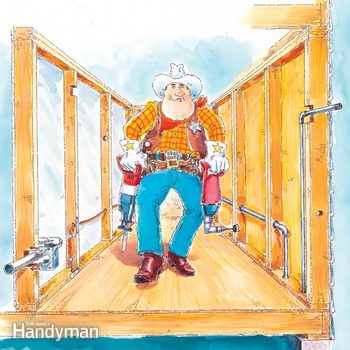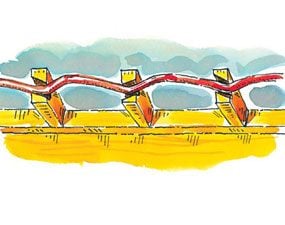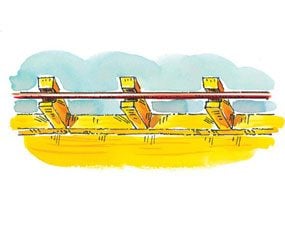What Size Hole Is Required To Run Electric
Drilling Holes: Notching and Boring Holes in Wood Studs
Updated: Sep. 21, 2017
How much wood are you allowed to cut out of a stud?

Building codes specify allowable sizes and locations for holes and cuts in studs. Here's a handy guide to those requirements that will go along your building continuing alpine.
Yous might too like: TBD
Overview
You get two benefits when y'all build or remodel with wood studs. The studs provide the strength and framework for the structure, and the empty spaces betwixt the studs serve an important function, too: They provide the perfect place—a veritable vertical freeway—to run pipes, vents, drains, wires and ductwork. The drawback? When yous have to run pipes, ducts or wires horizontally through the studs, you often have to notch or drill holes—sometimes big ones—to get them to their destination. But y'all can't simply drill and saw away. At that place are rules you have to follow for drilling and notching studs. Some rules help ensure the structural integrity of a wall. And others are aimed at protecting pipes and wires that could be damaged by screws, nails and other fasteners driven into a wall.
Figure A: Rules for Notching and Irksome Studs
Building codes let you to drill bigger holes and cutting bigger notches in not-load bearing walls than in load-bearing walls.
Figure A is likewise available every bit a pdf in Additional Information below.
Yous have to keep the structure strong
There are LOTS of building codes dictating just how large a hole or notch yous tin can cut (Fig. A). The technical yet important rules are:
- Holes in bearing wall studs (exterior and interior walls that bear the weight of the roof and/or other stories higher up) may not exceed 40 per centum of the width of the stud.
- Notches in bearing wall studs may not exceed 25 percent of the stud'southward width.
- Holes in non-bearing walls can't exceed 60 pct of their width.
- Notches in not-begetting walls tin't exceed twoscore pct of their width.
- The edge of a hole must be at least v/8 in. from the edge of a stud.
To appease the plumbing gods, the codes have fabricated at least one notable exception: In begetting walls yous tin bore threescore percent size holes—as long as you double up the studs and don't drill through more than two successive pairs of these doubled-up studs (Fig. A). This allows yous to run a short section of "drain, waste, vent" (DWV) pipe through a 2×four wall without beefing up the whole wall to two×half-dozen dimensions.
At that place are other, less specific guidelines:
When possible, notch a stud virtually the tiptop, rather than the bottom. Don't locate holes and notches near big or loose knots, and don't group too many in the aforementioned surface area of the stud. Finally, notch merely when necessary; holes weaken it less than notches.
In areas subject to high winds, earthquakes or tornadoes, maintaining wall force is particularly important. Furthermore, studs with too much "meat" removed tend to bow and warp. Your edifice inspector will be on the lookout for overzealous notching and boring, then follow the rules.
In reality, few walls always out-and-out collapse during everyday duty from being riddled with too many holes and notches. Merely in that location are LOTS of cases in which unprotected or inadequately protected pipes and wires have been nicked and punctured past screws and nails. Any plumber or electrician volition tell you that's what yous Really need to watch out for!
Protect those wires and pipes
The National Electrical Lawmaking requires holes containing non-metallic cable (often called Romex) or flexible metallic-clad cable (the blazon you purchase with the wires already in information technology) be set back 1-1/4 in. or more than from the edge of a stud (Fig. A) to protect the wires from nails and screws. (The 1-i/4-in. screws and nails used to secure 1/2-in. drywall penetrate the studs well-nigh iii/four in.) Virtually electricians keep their inspector happy by drilling 3/4-in. holes dead center on a 3-i/2 in. wide stud. This gives them a hole large enough to run two electrical cables and leave 1-3/eight in. of protective wood on each side. If they need to run more wires, they'll drill more holes directly in a higher place the others. If a hole comes whatsoever closer than 1-1/four in., your inspector will brand you install a i/16-in. thick protective metal plate (Fig. A). Available in 3-in. and longer lengths, the plates tin be institute at home centers and hardware stores.
The mechanical codes for plumbing and heating, ventilation and cooling (HVAC) systems also dictate that holes containing pipes be set back 1-1/4 in. from the edge of a stud to protect the pipes from fasteners. Those that come closer need to be covered past metal plates; for big pipes, utilise a long protective plate.
Electricians and plumbers spend lots of time drilling big holes, and then they know a few tricks to make the job easier (or avoid information technology birthday).
Figure B: Drilling
Employ a correct angle drill with hole saw bits for boring large holes. Keep the holes centered on the studs and a consistent top off the floor.
Tips for less drilling and notching
- Before kickoff any projection, plot out exactly where large pipes and ducts volition run and decide how you'll get them there.
- Wherever possible, run large pipes and ducts vertically into unfinished attics or basements, then install elbows and run the piping or duct horizontally below the floor joists or above the ceiling joists.
- Build two×6 stud walls where DWV pipes and holes exceed the limits shown in Fig. A.
- Rent a correct bending drill and use Selfeed or hole saw bits for boring large holes (Fig. B). The right angle drill allows you to drill holes square to the stud face up. Holes drilled at an angle will current of air upward oval and therefore larger.
- Drill holes at least 1/iv in. oversize, especially for hot water pipes. If you don't, they'll make annoying sounds as they expand, contract and rub along studs.
- Joist hanger manufacturers sell wrap-around, stud reinforcer plates (Fig. A). Ask your inspector if they are permissible in special situations.
- When dull electrical holes, keep them foursquare to the stud for easier wire installation, or pulling. This may seem trivial, but angled holes like those shown in Fig. C "catch" the wire and continue you from pulling wire through more two or 3 studs at a time. Holes in a line (Fig. D) let you pull wire through an entire wall length of studs at one fourth dimension.
Additional Information
- Figure A: Rules for Notching and Slow Studs
Required Tools for this Project
Have the necessary tools for this DIY project lined upward before you lot start—you'll save time and frustration.
The best tool for drilling holes in studs is a right-angle drill with cocky-feeding bits.
Required Materials for this Project
Avoid last-infinitesimal shopping trips past having all your materials set ahead of time. Hither's a list.
Originally Published: June twenty, 2017
What Size Hole Is Required To Run Electric,
Source: https://www.familyhandyman.com/project/drilling-holes-notching-and-boring-holes-in-wood-studs/
Posted by: chongdamitish.blogspot.com




0 Response to "What Size Hole Is Required To Run Electric"
Post a Comment